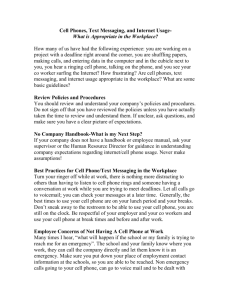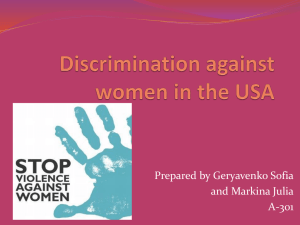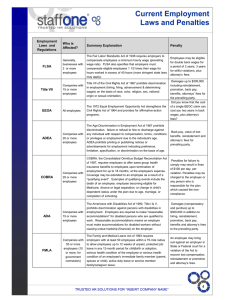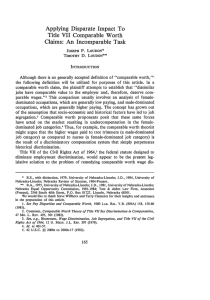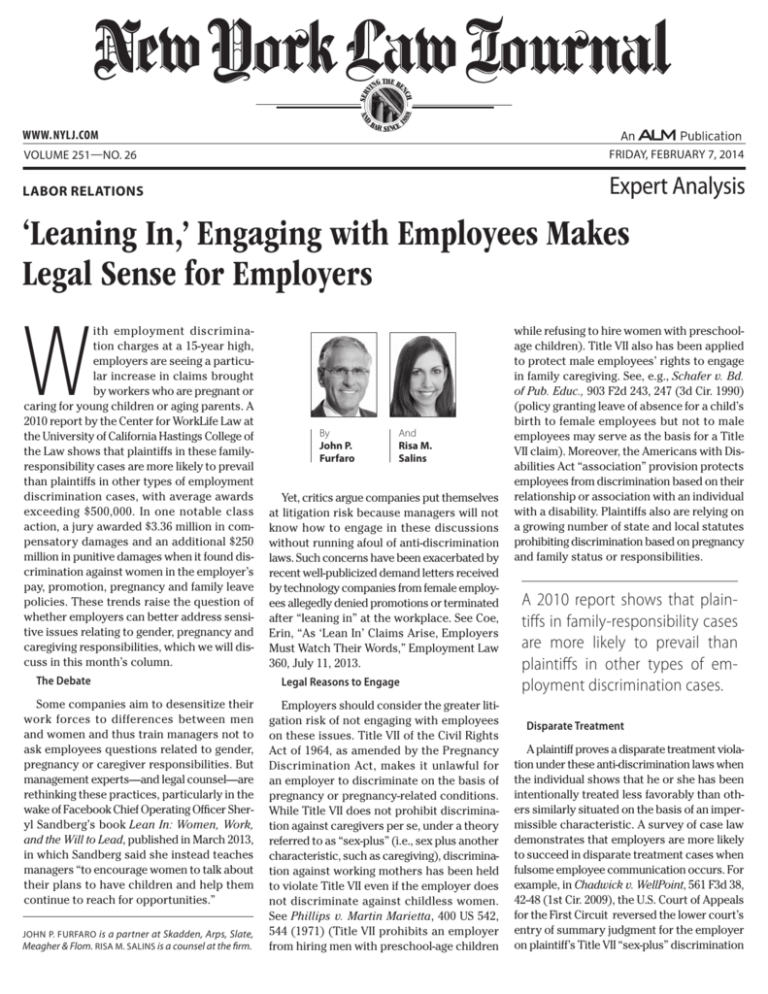
AND
88
8
SER
V
H
NC
THE BE
ING
1
BA
R SINCE
WWW. NYLJ.COM
VOLUME 251—NO. 26
FRIDAY, FEBRUARY 7, 2014
LABOR RELATIONS
Expert Analysis
‘Leaning In,’ Engaging with Employees Makes
Legal Sense for Employers
W
ith employment discrimination charges at a 15-year high,
employers are seeing a particular increase in claims brought
by workers who are pregnant or
caring for young children or aging parents. A
2010 report by the Center for WorkLife Law at
the University of California Hastings College of
the Law shows that plaintiffs in these familyresponsibility cases are more likely to prevail
than plaintiffs in other types of employment
discrimination cases, with average awards
exceeding $500,000. In one notable class
action, a jury awarded $3.36 million in compensatory damages and an additional $250
million in punitive damages when it found discrimination against women in the employer’s
pay, promotion, pregnancy and family leave
policies. These trends raise the question of
whether employers can better address sensitive issues relating to gender, pregnancy and
caregiving responsibilities, which we will discuss in this month’s column.
The Debate
Some companies aim to desensitize their
work forces to differences between men
and women and thus train managers not to
ask employees questions related to gender,
pregnancy or caregiver responsibilities. But
management experts—and legal counsel—are
rethinking these practices, particularly in the
wake of Facebook Chief Operating Officer Sheryl Sandberg’s book Lean In: Women, Work,
and the Will to Lead, published in March 2013,
in which Sandberg said she instead teaches
managers “to encourage women to talk about
their plans to have children and help them
continue to reach for opportunities.”
JOHN P. FURFARO is a partner at Skadden, Arps, Slate,
Meagher & Flom. RISA M. SALINS is a counsel at the firm.
By
John P.
Furfaro
And
Risa M.
Salins
Yet, critics argue companies put themselves
at litigation risk because managers will not
know how to engage in these discussions
without running afoul of anti-discrimination
laws. Such concerns have been exacerbated by
recent well-publicized demand letters received
by technology companies from female employees allegedly denied promotions or terminated
after “leaning in” at the workplace. See Coe,
Erin, “As ‘Lean In’ Claims Arise, Employers
Must Watch Their Words,” Employment Law
360, July 11, 2013.
Legal Reasons to Engage
Employers should consider the greater litigation risk of not engaging with employees
on these issues. Title VII of the Civil Rights
Act of 1964, as amended by the Pregnancy
Discrimination Act, makes it unlawful for
an employer to discriminate on the basis of
pregnancy or pregnancy-related conditions.
While Title VII does not prohibit discrimination against caregivers per se, under a theory
referred to as “sex-plus” (i.e., sex plus another
characteristic, such as caregiving), discrimination against working mothers has been held
to violate Title VII even if the employer does
not discriminate against childless women.
See Phillips v. Martin Marietta, 400 US 542,
544 (1971) (Title VII prohibits an employer
from hiring men with preschool-age children
while refusing to hire women with preschoolage children). Title VII also has been applied
to protect male employees’ rights to engage
in family caregiving. See, e.g., Schafer v. Bd.
of Pub. Educ., 903 F2d 243, 247 (3d Cir. 1990)
(policy granting leave of absence for a child’s
birth to female employees but not to male
employees may serve as the basis for a Title
VII claim). Moreover, the Americans with Disabilities Act “association” provision protects
employees from discrimination based on their
relationship or association with an individual
with a disability. Plaintiffs also are relying on
a growing number of state and local statutes
prohibiting discrimination based on pregnancy
and family status or responsibilities.
A 2010 report shows that plaintiffs in family-responsibility cases
are more likely to prevail than
plaintiffs in other types of employment discrimination cases.
Disparate Treatment
A plaintiff proves a disparate treatment violation under these anti-discrimination laws when
the individual shows that he or she has been
intentionally treated less favorably than others similarly situated on the basis of an impermissible characteristic. A survey of case law
demonstrates that employers are more likely
to succeed in disparate treatment cases when
fulsome employee communication occurs. For
example, in Chadwick v. WellPoint, 561 F3d 38,
42-48 (1st Cir. 2009), the U.S. Court of Appeals
for the First Circuit reversed the lower court’s
entry of summary judgment for the employer
on plaintiff’s Title VII “sex-plus” discrimination
FRIDAY, FEBRUARY 7, 2014
claim where the plaintiff, who was objectively
the most qualified for promotion, was informed
she had not been selected because, as a mother
of four young children, she had “too much on
her plate”; the court stated that “an employer is
not free to assume that a woman, because she
is a woman, will necessarily be a poor worker
because of family responsibilities.”
Likewise, in Lust v. Sealy, 383 F3d 580 (7th
Cir. 2004), the court upheld a jury’s finding that a female sales representative was
passed over for promotion in violation of
Title VII, where the supervisor admitted he
didn’t consider recommending her for the
position because she had children and he
didn’t think she would want to relocate her
family, even though she had not told him
that. See also Trezza v. The Hartford, No 98
Civ 2205, 1998 WL 912101, at *7-8 (SDNY
Dec. 30, 1998)(denying employer’s motion
to dismiss discrimination claims where
complaint alleged that employer assumed,
without discussing, that plaintiff would not
be interested in promotion to a managing
attorney position because she had a family
and the position required travel). In addition, in Scheidecker v. Arvig Enterprises, 122
FSupp2d 1031, 1045-46 (D. Minn. 2000), the
Minnesota district court denied summary
judgment on discrimination claims brought
by female employees who were terminated
during their pregnancies or while on maternity leave. The court was swayed by evidence
that management had not discussed details
of the plaintiffs’ maternity leaves with them
despite their requests.
In contrast, in O’Neill-Marino v. Omni
Hotels Management, No 99 Civ 3793, 2001
WL 210360, at *5 (SDNY March 2, 2001),
the Southern District of New York granted
summary judgment dismissing a former
employee’s claims that her employer
imposed unreasonable work hours to force
a resignation because she was a married
woman with children. The hotel demonstrated the work hours were a requirement
of the employee’s position and management
communicated with her about attendance,
provided advance notice of her schedules
and offered her an opportunity to take
another position in the hotel. See also
Spann v. Abraham, 36 SW3d 452 (Tenn Ct
App 1999) (no prima facie discrimination
where, following the employee’s absences
due to pregnancy, the employer suggested
the employee accept a temporary reassignment with no loss of pay and reinstatement
to her position after she returned from
maternity leave).
Workplace Policies
Employers also would be well-served to
openly communicate with employees about
workplace policies in an effort to avoid findings
of disparate impact discrimination. Disparate
impact may result when rules applied to all
employees have an unjustified adverse impact
on members of a protected class. For example,
in Lochren v. County of Suffolk, No CV 01-3925,
2008 WL 2039458 (EDNY May 9, 2008), the
plaintiffs prevailed on their disparate impact
challenge to the Suffolk County police department’s restriction of light duty work to those
with on-the-job injuries. The plaintiffs showed
that prior to the restriction, pregnant women
had been more likely to use light duty than
other officers, and women had been affected
more than men by the restrictions.
The flip side of discrimination is
active engagement, and a number of employment laws explicitly require employers to engage
with employees on family and
medical issues.
Employers may not be cognizant that
facially neutral policies are having a disparate
impact on certain groups unless they encourage employees to come forward and discuss
workplace policies and issues affecting them.
Interaction Required
The flip side of discrimination is active
engagement, and a number of employment
laws explicitly require employers to engage
with employees on family and medical issues.
For example, under the federal Family and
Medical Leave Act, when an employer acquires
knowledge that leave requested by an employee may be for an FMLA purpose, the employer
must inform the employee of his or her rights
and responsibilities under the FMLA. 29 CFR
§825.300(b)(1). And the ADA requires employers to initiate an interactive process with an
individual with a disability who may be in
need of a workplace accommodation. 29 CFR
§1630.2(o)(3).
Thus, in LaCourt v. Shenanigans Knits, Index
No 102391/11, 2012 NY Slip Op 52379(U) (Sup
Ct New York Co. Nov. 14, 2012), the Supreme
Court, New York County, denied summary judgment on the plaintiff’s ADA claims where the
employer terminated an employee who had
been diagnosed with breast cancer, because
she planned an absence from work for more
than three months following double mastectomy surgery. The court reasoned the employer
did not engage in an interactive process and
ultimately failed to establish that granting
the employee a leave of absence would have
resulted in an undue hardship.
Moreover, in Romanello v. Intesa Sanpaolo,
2013 Slip Op 6600 (NY Oct 10, 2013), the New
York Court of Appeals reinstated the plaintiff’s disability discrimination claim under
the New York City Human Rights Law where
the plaintiff, after five months of medical
leave, informed his employer that his return
to work date was “indeterminate,” and his
employer allegedly responded by terminating
his employment without further discussion.
Notably, the ADA Amendments Act of 2008
expands the definition of “disability” under
the ADA to include temporary impairments.
29 CFR §1630.2(j)(1)(ix)(“effects of an impairment lasting or expected to last fewer than six
months can be substantially limiting within the
meaning of this section”). Therefore, though
pregnancy itself is not a disability covered by
the ADA, certain impairments resulting from
pregnancy, such as hypertension, gestational
diabetes, severe nausea and sciatica, are now
considered disabilities for which employers
must engage in an interactive process and
provide reasonable accommodation.
Conclusion
Engaging with employees on sensitive personal issues is serious business but, if undertaken correctly, can be a win-win for employees and employers. Such engagement requires
that male and female employees, with proper
training and support, feel comfortable broaching pregnancy, parenting, personal or family medical issues and an employee’s related
workplace needs. Likewise, supervisors must
be trained with respect to preventing discrimination, harassment and retaliation based
on gender, pregnancy or caregiving responsibilities, and they must encourage employees
to raise these issues. This approach necessitates a focus on when and how to address
the particular workplace needs of employees
who are pregnant or disabled or who have
caregiving responsibilities, whether or not the
topic is raised by an employee. Employers
who take the time to address these aspects of
their employees’ lives are more likely to retain
the broadest array of a talented work force.
Reprinted with permission from the February 7, 2014 edition of the NEW YORK
LAW JOURNAL © 2014 ALM Media Properties, LLC. All rights reserved. Further
duplication without permission is prohibited. For information, contact 877-257-3382
or reprints@alm.com. # 070-02-14-07




